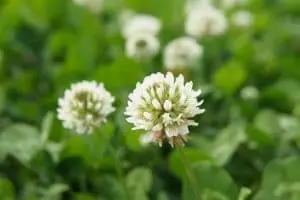Found in lawns throughout the United States, clover is a perennial weed that grows easily in moist areas. At first glance, the petite flowers look like a pretty addition to yards and gardens, but this aggressive weed is sure to spread and may possibly choke out some of the plants or grasses you chose for your landscaping. Once established, it’s hard controlling clover in your lawn—you’ll need the following tips and some patience to do so.
White Clover, Over and Over
There are many types of this perennial weed, but white clover (Trifolium repens) is the most common. Deep green in color, the clover plant consists of three leaves grouped together. Each leaf is tear-shaped and may have a dark stripe on it. Spiked white flowers top off the low-growing plant and are an excellent source of nectar for bees.
Clover seeds germinate best in cool, damp environments. Once sprouted, these hard, resilient seeds turn into a quick-spreading weed that roots to the ground wherever a stem node touches the soil. These runners, or stolons, create a dense mat that can easily choke out grass as it continues to spread.
How to Get Rid of Clover in Your Lawn
A healthy lawn is half the battle when it comes to eliminating clover. This aggressive weed is more likely to latch onto lawns that are sparse and not well maintained. Thick, lush lawns don’t give it, as well as other weeds, a chance to spread.
- Fertilizing is key since it not only encourages good grasses and plants to grow, but it also makes the environment less suitable for clover.
- If you find clusters of clover in your lawn try letting the grass grow a little higher by adjusting the mower blades. Longer grass helps to choke out the clover and blocks it from getting sunlight.
- Use a thick layer of mulch in gardens and landscaped areas to help prevent the clover seeds from germinating.
- Hand pulling. Because white clover grows in clusters, it’s an easy target for the hand-pulling method when it appears in smaller areas. Just be sure to get the entire root system when you pull.
When manually pulling out clover is too big of a task, use an weed control spray. This is a more efficient method for killing the invasive weed when it is covering a larger area. But care must be taken that the weed control does not also harm the plants and grasses you wish to keep. Pairing the hand-pulling method with a weed control spray is the best approach.
Killing clover is not actually difficult—it’s getting rid of the seeds that is the real issue. You may think you have successfully eliminated clover from your lawn, only to discover those little white flowers returning the following year. Contact Free Spray Lawn Care at 419-529-5296 to find out more on how to keep your yard free of weeds.



Comments (0)
Thanks for your comment!
Thanks for your feedback! Your comments have been successfully submitted! Please note, all comments require admin approval prior to display.
Error submitting comment!
There is a problem with your comment, please see below and try again.